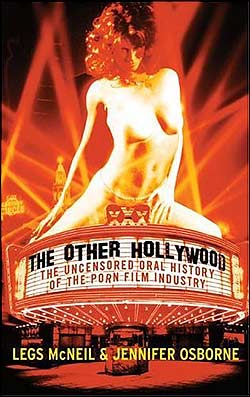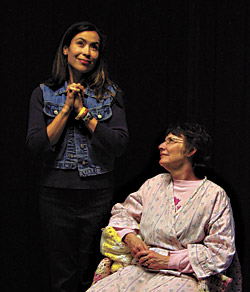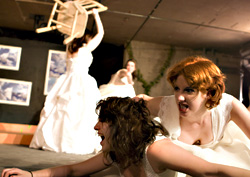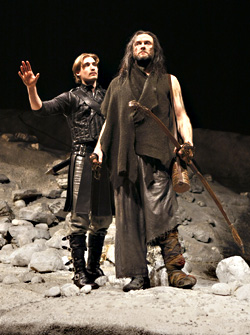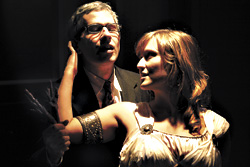This isn’t just the best oral history since co-author Legs McNeil’s punk opus Please Kill Me. It’s the best one since Jean Stein and George Plimpton’s Edie. The Other Hollywood: The Uncensored Oral History of the Porn Film Industry (ReganBooks, $27.95) is as fascinating as porn movies are boring, because instead of being about repetitively colliding body parts, it’s about people—remarkably flamboyant people. I doubt it would be interesting to see Linda Lovelace’s Dog Fucker, a flick depicting just that, but it’s absorbing to hear her intimates argue about her motives and the movie’s effect on her career. Hugh Hefner’s Playboy After Dark TV show was deadly dull, but this book’s chronicle of Lovelace’s orgy with Hef (who “knew what he was doing”) and her sexually ineffectual husband/manager—with her successor, Marilyn Chambers, watching from poolside, yearning to be part of the action like Eve Harrington— is a kind of mini–Rules of the Game of porn.
McNeil and co-author Jennifer Osborne depict plenty of horror, too. People overdose, kill themselves and one another, drive like maniacs, get flung out of windows, and fling severed penises out of windows while driving like maniacs. FBI agents go undercover and sometimes don’t come back, consumed by their fantasy underworld roles. People get raped, and AIDS outbreaks threaten to spark epidemics in 1998 and 2004.
Yet The Other Hollywood isn’t a simplistic depiction of nihilists in midself- immolation. Colorful personalities erupt from every quote. People behave irresponsibly to mind-bending extremes, but they also band together and look out for one another. In the book, they argue about the moral meanings and consequences of acts that look meaningless on camera and explicate the infinitely more riveting backstage dramas that animate the sets. There are even spotlights of spiritual uplift. A porn starlet since the ’70s, Sharon Mitchell becomes a heroine by rising from hard-core heroin addiction, potential imprisonment, and near murder by a crazed misogynist “fan” to sobriety, a Ph.D., and a stand-up job as the industry’s savior from AIDS. When one of her best friends and roommates turns out to have been the (male) Typhoid Mary of the San Fernando Valley porn world, she has to break through his denial and inform him of his HIV status. It’s poignant—and not just because he was her partner in her last sex scene. There’s even a happy postscript: Two of the AIDS–infected performers— including a woman who was forced out of medical school when authorities got wind of her porn career—fall in love and, with careful medical advice, have an HIV–negative baby.
You may have heard about many of the notorious episodes and figures covered here, but not in such vivid detail. Even a great movie like Boogie Nights or a fact-packed movie like Wonderland captures less of the astounding story of John Holmes than The Other Hollywood. Granted, there’s an unavoidably repellent, lurid allure to the drug-dealer massacre he helped engineer, but the deeper drama is the group psychology of his wife, lover, co-stars, and drug-club kingpins and cronies. Likewise, the demise of porn’s brattiest star, Savannah, almost seems tragic thanks to the book’s contrapuntal Greek chorus. After a minor car crash broke her nose, vanity drove her to shoot her brains out.
Much of the book is startlingly funny, in a scary Tarantino kind of way. Porn mobster Joe “the Whale” Peraino survived a nine-bullet fusillade, seven of them in the butt, because he was so massively fat the bullets couldn’t reach his vital organs. When Savannah said of her boyfriend, “Pauly [Shore] and I share the same brain,” her screenwriter replied, “Well, who’s using it now?” While proudly watching one of her films from the audience, Mitchell noticed “an older gentleman masturbating to me giving John Leslie head on-screen.” She decided to make his fantasy come to life by blowing him in the theater. When he glanced down and realized the woman on the screen was in his lap, he had a heart attack. Mitchell got an ambulance. “As they were carrying him out, he gasped to me in this tiny whisper, ‘Thank you.'”
Some of McNeil and Osborne’s revelations are confounding. Feminists will be appalled to read that Lovelace concluded that antiporn feminists were just as exploitative to her as the porn industry and her wife-beating husband. (See the current documentary Inside Deep Throat for more on the subject.) They’ll be puzzled when porn star Kristen Steen describes her rape in her first on-camera performance, then later refuses to condemn the industry. Today, she says, “As an adult female, I didn’t appreciate somebody infantilizing me and portraying me as someone who needs protection from the big, bad phallus—or my own fantasies.”
The backstage spectacle of porndom may not inspire readers to be so defensive. But it does suggest that some of its critics make the same mistake as some of its perpetrators and consumers: They fail to regard its stars as human beings with a will of their own.
Legs McNeil and Jennifer Osborne will appear at Bailey/Coy Books (414 Broadway Ave. E., 206-323-8842), 7 p.m. Wed., March 2; and at University Book Store, 7 p.m. Thurs., March 3.
